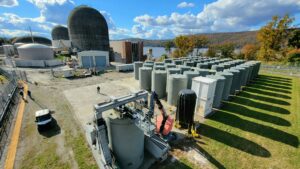
by Rich Burroni, a lifelong resident of Westchester County, and Holtec’s Site Vice President for Indian Point.
For another point of view on Indian Point decommissioning, see HERE.
The sale of Indian Point in May 2021 to Holtec International meant that decommissioning activities on the 240-acre property could be completed much sooner than if Entergy had continued to own the closed facility. The federal government allows “shutdown nuclear plant” operators up to 60 years to decommission sites, while Holtec plans to have everything on the site cleared by the mid-2030s, except where the nuclear spent fuel is stored.
Sooner doesn’t mean less safe, however.
Both the NRC (Nuclear Regulatory Commission), which approved the transfer of Indian Point’s licenses to Holtec in November 2020, and the New York State Public Service Commission, which approved the transfer on May 19, 2021, are onsite frequently. The NRC has to approve regulatory filings that Holtec has made to reflect its status as a shutdown nuclear facility, including a License Amendment Request for a Permanently Defueled Emergency Plan and exemptions involving liability and property damage insurance, as well as cyber security requirements.
***
A major focus of Indian Point’s decommissioning process is the safe transfer of the used nuclear fuel assemblies from Spent Fuel Pools in Unit 2 and Unit 3 to dry fuel storage on the Independent Spent Fuel Storage Installation, or ISFSI pad. This includes spent nuclear fuel from Unit 2’s shutdown in April 2020, and when Unit 3 shut down a year later in April 2021 — ending 59 years of nuclear operations at Indian Point, beginning in 1962.
The dry fuel storage process at Indian Point uses Holtec technology to safely move the spent nuclear fuel from the two units’ Spent Fuel Pools to the ISFSI pads. Four casks, each filled with 32 fuel assemblies from Unit 2, were moved safely from Unit 2’s Spent Fuel Pool to storage on the ISFSI pad last fall. Between August and October 2023, another 69 HI-STORMS will be placed on the existing ISFSI pad and the second one under construction.
The spent fuel is stored within Holtec HI-STORM 100s, which are vertical, ventilated, cylindrical overpacks engineered to minimize the local area radiation dose and are designed to easily withstand high-velocity winds, tornadoes, high-energy lightning, and other natural phenomena.
***
Vessel segmentation is the second major emphasis in decommissioning Indian Point.
The existing equipment hatches on Unit 2 and Unit 3 had to be enlarged because they weren’t big enough to allow the removal of large pieces of equipment. Workers used water cooled, diamond-encrusted wires to cut the concrete, rebar and steel liners of the containment buildings. The system, when combined with maintaining a negative air pressure in the buildings, prevented dust and silica from being released into the atmosphere.
Insulation, piping and reactor support components that are not integral to the Reactor Coolant System or Reactor have been removed. Both reactors’ cavities will be flooded to enable specially trained workers to cut up the remaining internal portions of the reactors while working underwater. This work is scheduled to start in late August or early September 2022 in Unit 3 and in March 2023 in Unit 2.
***
At the same time as dry fuel storage and vessel segmentation projects are proceeding, site cleanup around Indian Point’s 240 acres is proceeding. More than 82,000 cubic feet of waste has been transported by truck and rail from Indian Point to Texas. Equipment and buildings no longer needed are being removed.
After all the spent nuclear fuel is on the ISFSI pads in October 2023, Indian Point will transition from decommissioning to demolition. Every demolition project requires a building permit from the Village of Buchanan and Holtec is examining the best engineering techniques to remove buildings safely.

Local building contractors have advised us to “wet down” buildings to decrease generating dust, and we will examine dust prevention options when planning future demolition projects. Many of the structures onsite are made of metal, such as large oil fuel storage tanks, which can be demolished by using giant mechanical sheers to “snip” the metal into pieces without generating dust.
All of the buildings will be demolished by the mid-2030s.






Would like to see pictures of the containment building being demo when the time comes.
Spent many years working outages there.